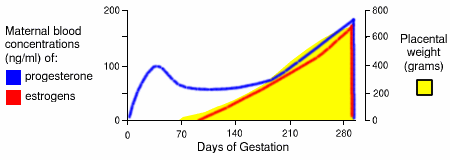In addition to its role in transporting molecules between mother and fetus, the placenta is a major endocrine organ. It turns out that the placenta synthesizes a huge and diverse number of hormones and cytokines that have major influences on ovarian, uterine, mammary and fetal physiology, not to mention other endocrine systems of the mother.
This section focuses only on the major steroid and protein hormones produced by the placenta. Additional details on placental endocrinology can be found in the Placental Hormones section of the Endocrine System text.
Steroid Hormones
Sex steroids are the best known examples of placental hormones. Two major groups are produced by all mammals:
Progestins: Progestins are molecules that bind to the progesterone receptor. Progesterone itself is often called the hormone of pregnancy because of the critical role it plays in supporting the endometrium and hence on survival of the conceptus.
The placentae of all mammals examined produce progestins, although the quantity varies significantly. In some species (women, horses, sheep, cats), sufficient progestin is secreted by the placenta that the ovaries or corpora lutea can be removed after establishment of the placenta and the pregnancy will continue. In other animals (cattle, pigs, goats, dogs), luteal progesterone is necessary throughout gestation because the placenta does not produce sufficient amounts.
Progestins, including progesterone, have two major roles during pregnancy:
- Support of the endometrium to provide an environment conducive to fetal survival. If the endometrium is deprived of progestins, the pregnancy will inevitably be terminated.
- Suppression of contractility in uterine smooth muscle, which, if unchecked, would clearly be a disaster. This is often called the "progesterone block" on the myometrium. Toward the end of gestation, this myometrial-quieting effect is antagonized by rising levels of estrogens, thereby facilitating parturition.
Progesterone and other progestins also potently inhibit secretion of the pituitary gonadotropins luteinizing hormone and follicle stimulating hormone. This effect almost always prevents ovulation from occurring during pregnancy.
Estrogens: The placenta produces several distinct estrogens. In women, the major estrogen produced by the placenta is estriol, and the equine placenta synthesizes a unique group of estrogens not seen in other animals. Depending on the species, placental estrogens are derived from either fetal androgens, placental progestins, or other steroid precursors.
With few exceptions, the concentration of estrogens in maternal blood rises to maximal toward the end of gestation. Two of the principle effects of placental estrogens are:
- Stimulate growth of the myometrium and antagonize the myometrial-suppressing activity of progesterone. In many species, the high levels of estrogen in late gestation induces myometrial oxytocin receptors, thereby preparing the uterus for parturition.
- Stimulate mammary gland development. Estrogens are one in a battery of hormones necessary for both ductal and alveolar growth in the mammary gland.
Like progestins, estrogens suppress gonadotropin secretion from the pituitary gland. In species like humans and horses, where placental estrogens are synthesized from androgens produced by the fetus, maternal estrogen levels are often a useful indicator of fetal well being.
The image below depicts changes in concentrations of progesterone and estrogens in the maternal serum of humans through gestation.

Protein Hormones
Several protein and peptide hormones are synthesized in placentae of various species. They have effects on the mother's endocrine system, fetal metabolism and preparation of the mother for postpartum support of her offspring.
Chorionic gonadotropins: As the name implies, these hormones have the effect of stimulating the gonads, similar to the pituitary gonadotropins. The only species known to produce a placental gonadotropin are primates and equids.
The human hormone is called human chorionic gonadotropin or simply hCG. This hormone is produced by fetal trophoblast cells. It binds to the luteinizing hormone receptor on cells of the corpus luteum, which prevents luteal regression. Thus, hCG serves as the signal for maternal recognition of pregnancy. The first hormone you produced was hCG!
Equine chorionic gonadotropin is also produced by fetal trophoblast cells. It is actually the same molecule as equine luteinizing hormone.
Placental lactogens: These hormones are molecular relatives of prolactin and growth hormone. These hormones have been identified in primates, ruminants and rodents, but not in other species.
The functions of placental lactogens are not well understood. They are thought to modulate fetal and maternal metabolism, perhaps mobilizing energy substrates for fetal use. In some species they have been shown to stimulate function of the corpus luteum, and to participate in development of the mammary gland prior to parturition.
Relaxin: Relaxin is a hormone thought to act synergistically with progesterone to maintain pregnancy. It also causes relaxation of pelvic ligaments at the end of gestation and may therefore aid in parturation. In some of the species in which relaxin is known to be produced, it is produced by the placenta, while in others, the major source is the corpus luteum. In some species, relaxin is produced by both the corpus luteum and placenta.
| 



